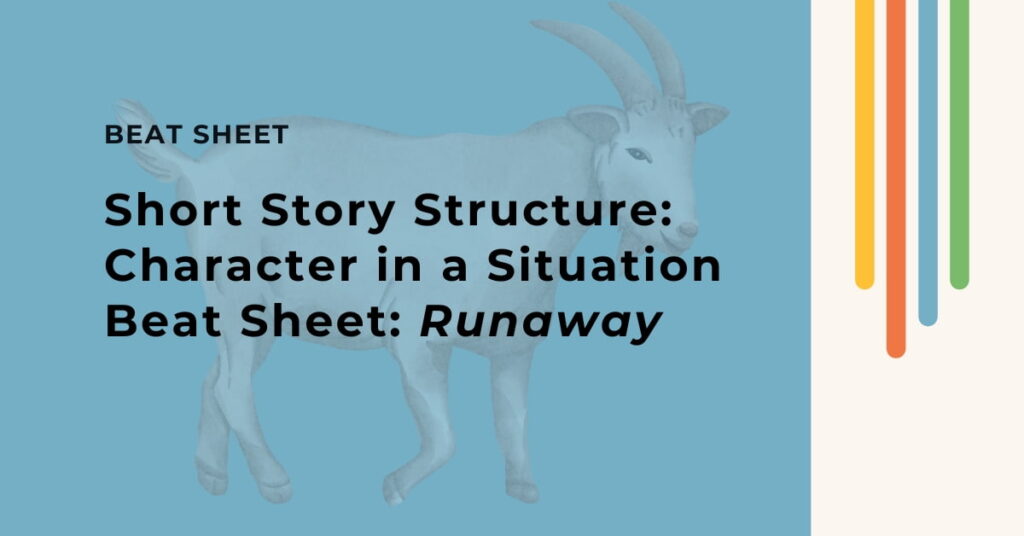Short story structure is hard. You have fewer words to get across character arcs and plot twists and turns. The character in a situation beat sheet is a seven-point plot structure that will help you make every page matter. Learn how, with ‘Runaway’ by Alice Munro.
What is the Character in a Situation Short Story Structure?
The Character in a Situation Short Story structure (available as a template in Plottr) has seven core beats:
- A Character. The first beat introduces the reader to a character’s everyday life, hinting at something that will disrupt it.
- In a Situation. Describe the situation a character is in and how it’s disrupting their everyday world.
- With a Problem. The situation creates a problem for the character that they must solve.
- Who Tries to Repeatedly Solve the Problem. In this section of the story, a character strives to solve the problem in varied ways. Here there may be allies or adversaries that help or hinder your character.
- But Fails, Making the Problem Worse. Show the character failing to solve the problem. Each time they fail, it may make their situation worse.
- The Final Attempt to Solve the Problem. Using what they’ve learned along the way, the character makes one final attempt to solve the problem.
- The Result of the Final Attempt. Show the character’s return to their situation in the ordinary world. Is the situation better due to their actions? Worse? Unchanged?
You can try the Character in a Situation Short Story template for yourself with a free 30-day Plottr trial. You’ll also find these short story templates:
Example: Short Story with Outline (Alice Munro’s ‘Runaway’)
Why read Alice Munro’s short story ‘Runaway’?
Munro wrote exclusively in this form, winning the Man Booker International in 2009 for her body of work in short stories, and the Nobel Prize in Literature in 2013.
Jonathan Franzen says, in his introduction to Runaway (Munro’s short story collection):
‘I like stories because they leave the writer no place to hide. There’s no yakking your way out of trouble; I’m going to be reaching the last page in a matter of minutes, and if you’ve got nothing to say I’m going to know it.’
Franzen describes Munro as having ‘almost pathological empathy for her characters’.
There has also been criticism more recently (such as in The New Yorker) surrounding Munro’s personal and family life, but for the purpose of analysis we’ll explore the story on its own merits.

Beat 1: A Character
Show the character’s everyday life, plus a hint something will disrupt it. Hint at some issue or problem that is making them unhappy.
We meet Carla, who hears a car coming and thinks it might be a woman named Mrs Jamieson, Sylvia Jamieson, home from a holiday in Greece.
Carla hopes it isn’t Sylvia, and hopes Clark, her partner, ‘doesn’t know yet’. What Clark is unaware of, the reader doesn’t know, creating a mysterious hook. Carla reassures herself that if Clark is at his computer, he’d have his back to the window and the road.
Carla thinks about how after dark, the lights on in Sylvia’s house will show that she’s home, and worries that the woman might phone soon.
Beat 2: In a Situation
Describe the character’s situation and how it’s impacting their ordinary world. There should be an issue that won’t resolve on its own. Show the character’s discomfort.
We learn more about Carla and Clark’s situation. They live in a mobile home where they board horses and offer trail rides, yet it’s been a rainy summer and nobody’s been showing up for rides.
Carla and Clark are in a financially precarious situation. Their mobile home needs repairs. Clark owes people money and gets in fights with random strangers and senior ladies in line at the drugstore.
When Carla confronts Clark, saying, ‘You flare up,’ he shrugs it off. ‘That’s what men do.’
Yet there’s something worse than Clark’s short temper (to Carla)…
Beat 3: With a Problem
The situation creates a problem for the character they must solve. Introduce the problem, connecting it back to the situation.
Problem 1: Flora, the Goat Disappears
Carla’s greatest problem at the moment is the disappearance of her white pet goat, Flora.
The goat keeps the horses company in the barn, and Carla finds comfort in visiting it whenever she’s feeling overwhelmed or stuck with her and Clark’s situation.
We backtrack to how the cracks appeared in Carla and Clark’s relationship. They moved to the mobile home three years before.
At first, Clark went along with Carla’s attempts to make the mobile home cozy. Yet Clark became increasingly withdrawn, spending all his time on the computer.
We learn how Flora had been Clark’s pet first, but grew more attached to Carla, forming a kind of ‘comradeship’ that doesn’t ‘allow’ Carla any sense of superiority.
Problem 2: Complicated Relations with the Jamiesons
Clark tells Carla that Sylvia called and wants Carla to go straighten up her house. Carla resists, saying she cleaned the house before Sylvia left on holiday and there can’t be much to clean so soon.
Clark keeps pressuring Carla to phone Sylvia and confirm. There’s a sense he is controlling and demanding.
Carla gets emotional, and goes over to Clark and puts her arms around his shoulders as he sits at the computer. She starts to cry, but he doesn’t comfort her telling her he hates it ‘when she gets like this.’ ‘Start supper,’ he demands.
Munro narrates how ‘it’ (the present situation) had started when Carla and Clark read the obituary for Sylvia’s husband Leon, a poet 20 years older than Sylvia. They found out Leon had received a large prize for poetry.
Clark starts to obsessively talk about how they could have ‘made him pay’ (Leon).
It turns out that Carla once told Clark that Mr Jamieson made advances on her, though the narration reveals she’d made it up (whether to make Clark jealous or for other reasons is ambiguous).
Beat 4: Who Tries to Repeatedly Solve the Problem
In this section, the character tries to solve the problem repeatedly, yet fails. Reveal any allies who help them or adversaries who try to stop them.
Carla tries to solve the first problem: her lost pet goat. She searches and whistles for Flora but there’s no reply.
Carla’s second problem is trickier (Flora’s missing is almost comforting by comparison): ‘the mess she had got into concerning Mrs Jamieson, and her seesaw misery with Clark.’
Recalling what has led up to the awkwardness with Mrs Jamieson, Munro flashes forward to after Mr Jamieson has died.
Third problem: Missing Connection (and Sylvia’s Attempts to Find It)
The story shifts to Sylvia Jamieson’s viewpoint as Carla cleans the house after Mr Jamieson has passed away.
Carla plants an absent-minded kiss on Sylvia’s head where she’s sitting as she passes by. Feelings emerge in Sylvia at this moment. She romanticizes Carla, picturing her as someone who is ‘Naturally happy’.
Flash forward to Carla being at Sylvia’s to clean after Sylvia returns from Greece. Sylvia hasn’t forgotten about that innocuous kiss the whole time, and has gotten Carla a gift, a small statue of a racehorse.
Carla thanks her, and Munro narrates how Sylvia had spoken about Carla to her friends while on holiday, telling them how comforting it was to see somebody ‘fresh and so full of health’ in the house while her husband was dying.
Her friends tease her that it’s a crush, and she says that maybe it’s because her and her husband never had children; that it’s ‘displaced maternal love.’
Solving Problems: Trying to Help (Carla to Leave)
Sylvia notices that Carla isn’t her usual self, and she tells her that Flora is gone. Carla admits that she can’t stand being with Clark anymore and that he acts as though he hates her.
Carla says that she would leave if she could, but that she hasn’t got any money or anywhere to go. Her family hates Clark.
Sylvia keeps asking Carla questions about what she’d do if she were to leave, and Carla says she’d move to Toronto and get a job at a riding stable. Sylvia confirms that all that’s holding Carla back is lack of money.
Sylvia tries to solve Carla’s problem by offering to help her with money and a place to stay with a friend of hers in Toronto, Ruth.
When Ruth asks Sylvia if Carla can manage a cab from the bus depot, Sylvia replies: “She’s not a lame duck, don’t worry. She is just a person in a bad situation, the way it happens.”
Sylvia brings up whether Carla will tell Clark she’s left, and Carla asks Sylvia to slip a note in the mailbox when she’s back from taking Carla to the bus depot.
The story flashes back to when Carla met Clark at 18, how her mom said he’d break Carla’s heart and nicknamed him ‘Gypsy Rover’ and her stepdad called him a drifter.
Beat 5: But Fails, Making the Problem Worse
Show the character failing. Each time they fail, make the problem worse than before. Highlight the mental, emotional and/or physical impact on the character and just how bad their situation has become.
As Sylvia pictures Carla getting onto the bus, she worries and calls Ruth again to warn her that Carla may be a bit ‘full of herself’. Meanwhile, on the bus, Carla remembers when she ran away with Clark at eighteen.
We see how in Carla’s first experience as a ‘runaway’, she failed to improve the problem: With Clark, ‘she saw him as the architect of the life ahead of them, herself as captive, her submission both proper and exquisite.’
It seems that Carla was running away from her parents and everything she despised about her life as much as she was running to Clark. Caught between desire for something and the desire for something (anything) else.
Carla tries to picture Toronto and can’t picture ‘living among hordes of people every day who [are] not Clark’. She wonders who else ‘could ever be so vivid a challenge?’
Carla makes the bus driver stop and calls Clark to come and get her.
Sylvia’s Failed Attempt to Solve the Problem
The narrative switches to Sylvia’s house. She’s forgotten to lock her door, and thinks she hears knocking.
A man’s voice comes, asking if he scared her. It’s Clark. He hands her the shopping bag she gave Carla full of clothes for her bus ride.
Alarmed, Sylvia asks where Carla is, and she can see from Clark’s face he’s enjoying her fear. He tells her that Carla is home in bed. Clark asks Sylvia whether she thinks he murdered Carla.
Sylvia tells Clark she helped Carla as his wife seemed to be in distress. He keeps referring to her as ‘my wife’ and Sylvia retorts, “She is a human being, besides being your wife.”
Clark tells Sylvia he doesn’t want her getting involved anymore and that Carla won’t be cleaning her house, that it’s time she learns to clean it herself.
Clark says Sylvia owes him something and moves, maybe to put out his hand (she can’t seem him in the dark of the patio so well) and she shrieks, “What’s that?”
Beat 6: The Final Attempt to Solve the Problem
Using what they have learned along the way, the character makes one final attempt to solve the problem which can either succeed or fail. Show the consequences the character faces, whether they solve the problem or not.
Clark asks Sylvia, “What’s what?”
Through fog in the trees, they see a white, unearthly-looking shape moving towards them and Clark instinctively reaches out to hold Sylvia’s shoulder.
Out of the refracted light, Flora the goat appears and Clark lets go.
Clark chastises the goat, saying she scared ‘Us’. The moment has unified him and Sylvia unexpectedly. The tension has broken and Clark tells Flora it’s time to go home.
Sylvia promises to stay out of his hair as Clark and Flora leave. Ruth calls, and Sylvia tells her there’s been a change of plan.
Back with Carla, Clark tells her he went to take the clothes back. Carla is alarmed, asking whether he told Sylvia ‘any of that stuff’ (about her husband), confessing she made it all up.
He tells her that when he read her note saying that she was leaving, he went hollow inside and that if she ever went away he’d feel like he didn’t have anything left in him. He doesn’t mention Flora the goat’s return, and she isn’t with him…
Carla and Clark refer to her bus trip as ‘Runaway Day’ and he says he’ll ‘tan her hide’ if she ever runs away again. Yet she now finds him as irresistible as when she first met him.
A woman who boards her horse with them asks what happened to Flora, and Clark tells her the goat ran away.
But then, after three or four days, Carla goes to check the mailbox and there’s a letter from Sylvia…
Beat 7: The Result of the Final Attempt
Show the character’s return to their situation in the ordinary world. Is the situation better due to their actions, worse, or unchanged?
Carla reads the letter from Sylvia.
The woman says she involved herself too closely in Carla’s life, and that she made the mistake of thinking Carla’s happiness and freedom were the same thing.
Sylvia reveals what happened with Flora’s apparition, saying it united her and Clark ‘in their humanity’.
Carla now knows that Clark found Flora and kept it from her. She crumples up the letter and burns it in the sink.
Carla tries not to think about it, now that Clark is never too tired, never cross, yet it feels as though she ‘has a murderous needle somewhere in her lungs’ and that by breathing carefully, she can avoid feeling it.
Reading between the lines, the reader asks, was Clark’s final attempt to solve the problem killing Flora?
Sylvia moves away to the college town where she taught.
Carla sometimes imagines walking to the edge of the woods and finding bones in the grass, a skull that she can hold ‘like knowledge in her hand’.
Then, Carla pictures Clark chasing Flora away instead, or having driven her somewhere to let her loose. She doesn’t go near the edge of the woods and holds out against the temptation.
Short Story Structure Insights from ‘Runaway’
Here are five things learned from reading Alice Munro’s story through the Character in a Situation template:
Multiple Characters in Situations Add Intrigue
There’s nothing to say you have to focus on a single character (though Carla is arguably the main character as the story begins and ends with her).
The complex triangle between husband and wife Clark and Carla and Mrs Jamieson weaves a web of desire, misbelief, and try/fail cycles.
Carla tries and fails to run away from her problems. Sylvia tries and fails to help Carla leave Clark, projecting her version of who Carla is and what she truly desires onto her.
Clark tries and fails to contain and constrain Carla and her emotions, needing her but only a version of her who is highly emotionally regulated, or who doesn’t insist on knowing the truth.
Problems Stacked on Problems Create Tension
Flora missing is already suspenseful. To this, Munro adds complicated relationship dynamics for further layers of problems.
Flora, the first problem, returns to both solve the second set of problems (the tension between Clark and Sylvia) and complicate them again (Carla’s discovery of Clark’s omission and the possibility he killed Flora).
Solutions Sometimes Make Other Things Worse
Sylvia assumes that she knows Carla and Clark and understands their dynamic better than she does. She doesn’t see how intervening could possibly leave Carla in a worse situation ultimately.
In helping Carla run away (and writing the letter), she unknowingly creates a situation where Carla may be more afraid to leave than before, as she wonders what violence Clark is capable of given the possibility he killed Flora.
Clark, likewise, hasn’t banked on the fact Carla could find out, or that his untruthfulness about Flora could eat away further at Carla’s trust or willingness to stay.
One Revelation can Change Tone, Mood and Perspective
Carla and Clark seem to be through the worst when Sylvia’s letter arrives (though Clark does threaten violence as though joking).
The revelation of Clark’s omission fills Carla with indecision between pursuing knowledge (and ultimately, power) and playing along with his desire to control her and the narrative.
Ambiguity is a Powerful Tool
Like Carla, the reader is left not knowing for certain whether Clark killed Flora or let her run free.
This ending has a haunting effect, as the reader may wonder whether Carla stays with Clark out of fear, or whether she turns a blind eye to things like ‘knowledge’ and ‘freedom’ for the sake of flawed (dis)comfort.
Ambiguity lets the reader interpret and come to their own conclusions based on a story’s evidence.
Start Plotting Anthology-Worthy Short Stories
Ready to start plotting your next short story? Try Plottr free for 30 days.
What’s your favorite short story? Comment below.



Comments